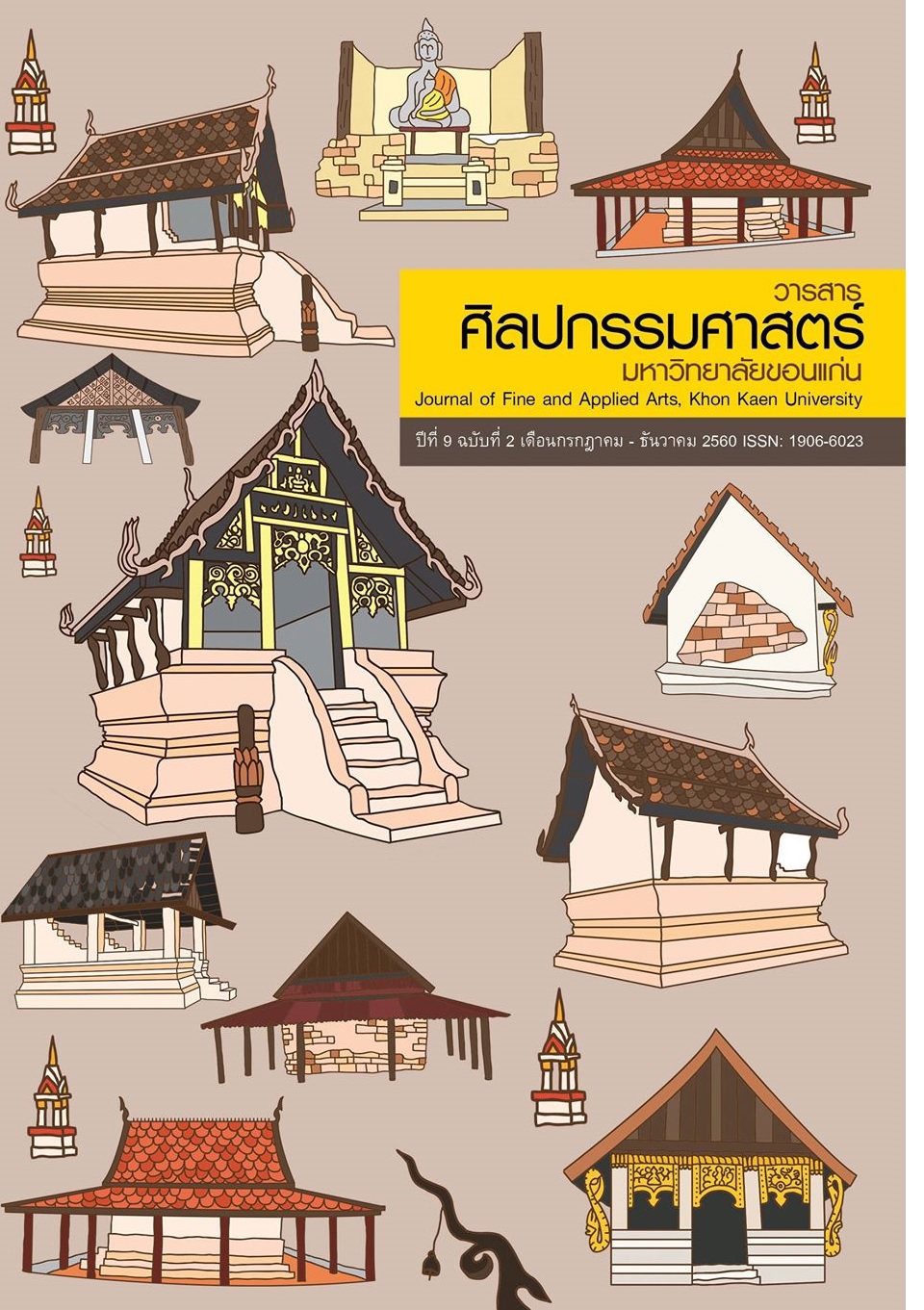การเป่าแคนประกอบลำทางสั้นของหมอลำจำนงค์ ฤาชา Khaen mouth organ Accompaniment in Lam Thang San style of Molam Jamnong Ruecha.
Main Article Content
Abstract
การเป่าแคนประกอบการลำทางสั้นของหมอลำจำนงค์ ฤาชา เป็นการวิจัยเชิงคุณภาพ มีวัตถุประสงค์คือ 1) เพื่อศึกษาประวัติและผลงานของหมอลำจำนงค์ ฤาชา และ 2) เพื่อศึกษาองค์ประกอบการเป่าแคนประกอบการลำทางสั้นของหมอลำจำนงค์ ฤาชา เครื่องมือที่ใช้ในการวิจัยได้แก่ แบบสังเกต และแบบสัมภาษณ์ ผู้วิจัยได้เก็บรวบรวมข้อมูลจากข้อมูลเอกสารและข้อมูลภาคสนาม ข้อมูลภาคสนามได้จากการสัมภาษณ์และการสังเกต โดยจัดขอบเขตด้านประชากรผู้ให้ข้อมูลดังนี้ กลุ่มผู้รู้จำนวน 5 คน กลุ่มผู้ปฏิบัติจำนวน 5 คน และกลุ่มผู้ให้ข้อมูลทั่วไปจำนวน 5 คน ระหว่างเดือน สิงหาคม 2558 ถึงเดือนกรกฎาคม 2559 นำข้อมูลที่ได้มาตรวจสอบความถูกต้องด้วยวิธีการแบบสามเส้า จัดหมวดหมู่ วิเคราะห์ตามวัตถุประสงค์ที่ตั้งไว้ และนำเสนอผลการวิจัยในรูปแบบพรรณนาวิเคราะห์
ผลการวิจัยพบว่า หมอลำจำนงค์ ฤาชา เป็นลูกชาวนา เกิดเมื่อปี พ.ศ. 2496 ที่อำเภอเกษตรสมบูรณ์ จังหวัดชัยภูมิ ปัจจุบันอาศัยอยู่ในอำเภอเมือง จังหวัดขอนแก่น หมอลำจำนงค์ ฤาชา เรียนลำจากครูสี่ท่านคือ หมอลำสำเภา พิมโนนทอง หมอลำสากล อริยะวงศ์ หมอลำขุนลำบน ฟ้าสะท้อน และหมอลำอุดม ธนูทอง หมอลำจำนงค์ ฤาชา เคยลำประจำคณะสุนทราภิรมย์ ที่กรุงเทพฯ เคยได้รับเชิญไปแสดง ที่ประเทศฮ่องกง ได้รับรางวัลชนะการประกวดหมอลำกลอนประยุกต์ที่จัดโดยสำนักงานคณะกรรมการวัฒนธรรมแห่งชาติ ได้รับรางวัลผู้สืบสานมรดกภูมิปัญญาทางวัฒนธรรมของกระทรวงวัฒนธรรมร่วมกับมหาวิทยาลัยขอนแก่น เกี่ยวกับองค์ประกอบการเป่าแคนประกอบการลำทางสั้นของหมอลำจำนงค์ ฤาชา พบว่าประกอบด้วยทำนองลำและทำนองแคน ทำนองลำนั้นเกิดจากเสียงสูงต่ำ สั้นยาวและรูปแบบของกลอนลำ ส่วนทำนองแคนจะประกอบด้วยสองลักษณะคือ เป่าเกาะเกี่ยวไปกับทำนองลำและเป่าแยกทางจากทำนองลำ ทำนองแคนแบ่งได้เป็นสามตอนคือ ทำนองตอนเกริ่น ทำนองที่เป็นเนื้อหา และทำนองตอนลง โดยมีลำดับขั้นตอน เริ่มด้วยแคนบรรเลงนำ หมอแคนยืนเสียงรอให้หมอลำเข้ามา หมอลำเกริ่น โอละนอ หมอแคนเป่าเสริม หมอแคนรอหมอลำ พอหมอลำเข้าสู่ทำนองลำที่เป็นตอนเนื้อหา หมอแคนจะรีบสรวมเข้ามาทันที่ แคนเป่าคลอทั้งเป่าตามทำนองลำและเป่าแยกจากทำนองลำตามความเหมาะสมจนกว่าหมอลำจะจบทำนองที่เป็นเนื้อหา ตอนจบกลอนหมอแคนจะเป่าเกาะเกี่ยวกับทำนองลำและจบลงด้วยทำนองเดียวกันกับทำนองลำ ที่มีคำว่า “สีนานวล...”
Khaen Mouth Organ Accompaniment in Lam Thang San Style of Molam Jamnong
Ruecha, a twofold qualitative study, aiming at: 1) examining on live and work of Molam
Jamnong Luecha; and 2) investigating on khaen accompaniment to Molam Jamnong Ruecha’
lam thangsan singing style. The research tools included a preliminary survey form, an
observation form, and an observation form. Written document and fieldworks were collected.
Fieldworks were obtained through interviews and observations from 5 key-informants, 5 casual
informants, and 5 general informants, between August 2015 and July 2016. The data were
checked for their accountability with triangulation techniques, classified, analyzed in accordance
with the given objectives, and presented in a descriptive analytical form.
The results of the study showed that Molam Jamnong Ruecha, a rice farmer’s son, was born in 1953 at Amphoe Kaset Somboon in Chaiyaphum Province. Now he live in Amphoe Mueang, Khon Kaen Province. He learned lam singing from four teachers, namely, Molam Samphao Phimnonthong, Molam Sakon Ariyawong, Molam Khunlambon Fasathan, and Molam Udom Thanuthong. Molam Jamnong Ruecha used to be a member of Suntharaphirom troupe in Bangkok. He was invited to perform in Hong Kong. He had received the first prize winner in lam klon prayuk competition hosted by the Office of National Culture and received heritage transferring award on cultural wisdom from the combined hosts of The Ministry of Culture and Khon Kaen University. Regarding the khaen accompaniment in lam thang san of Molam Jamnong Ruecha, it was found that there were two components lam melody and khaen melody. A lam melody was derived from tone pitches, duration of words, and form of a lam poetry whereas a khaen melody was played in two styles, imitating lam melody or deviating from the lam melody. A khaen accompaniment was divided into three sections introduction, main section, and ending section. A khaen accompaniment practice consisted of the following steps: khaen played the introduction; molam started with “O lano”; mo khaen gave the accompaniment and waited for molam to come in; molam came in with the main section and mo khaen moved in right away; then khaen came in with an imitation as well as playing differently from the lam melody until the end of the main section; at the end of lam thang san singing molam mostly ended with “si nanuan…”; then mo khaen imitated and ended the same melody as a lam singing.
Article Details
Content and information in articles published in the Journal of Fine and Applied Arts of Khon Kaen University is regarded as the opinion and sole responsibility of the author(s) directly; therefore, editors are not obliged to agree to or share any responsibility with regard to the content and information that appears within these articles.
All articles, information, content, image, etc. that have been published in the Journal of Fine and Applied Arts of Khon Kaen University is the copyright of the Journal of Fine and Appllied Arts of Khon Kaen University. Any person or organization who wishes to distribute all or parts of the articles for further dissemination or other usage must first receive permission from the Journal of Fine and Applied Arts of Khon Kaen University before proceeding to do so.


